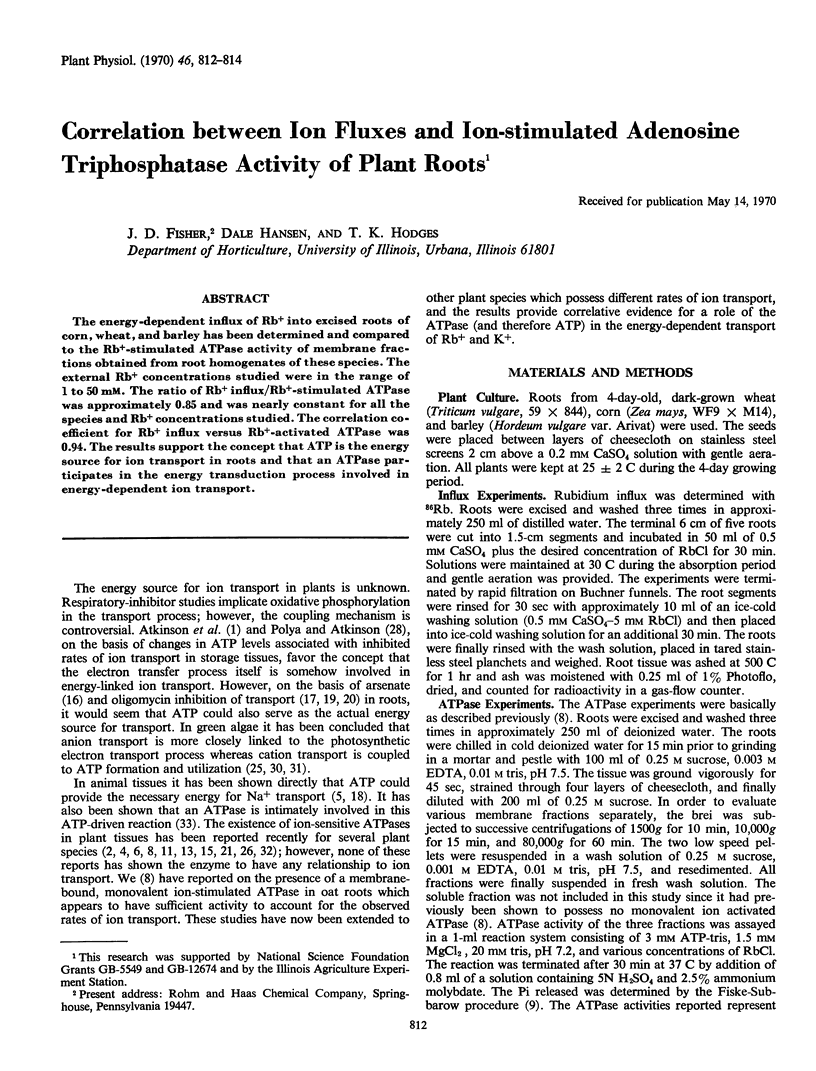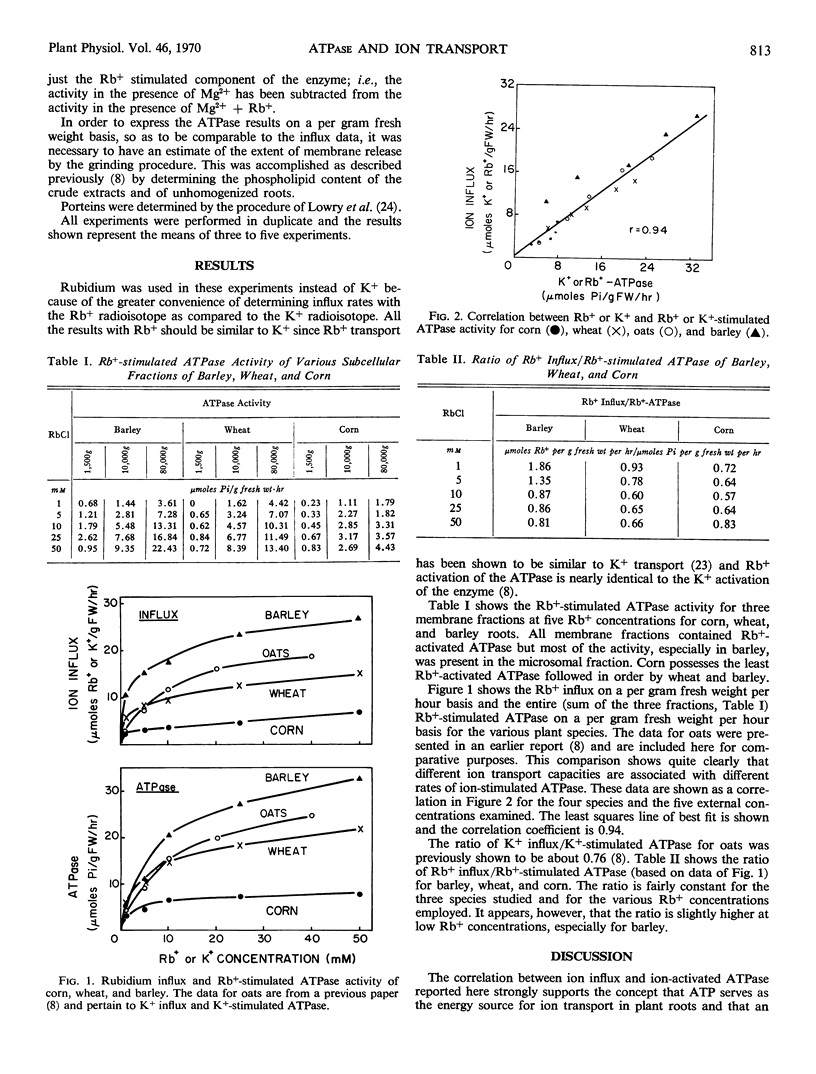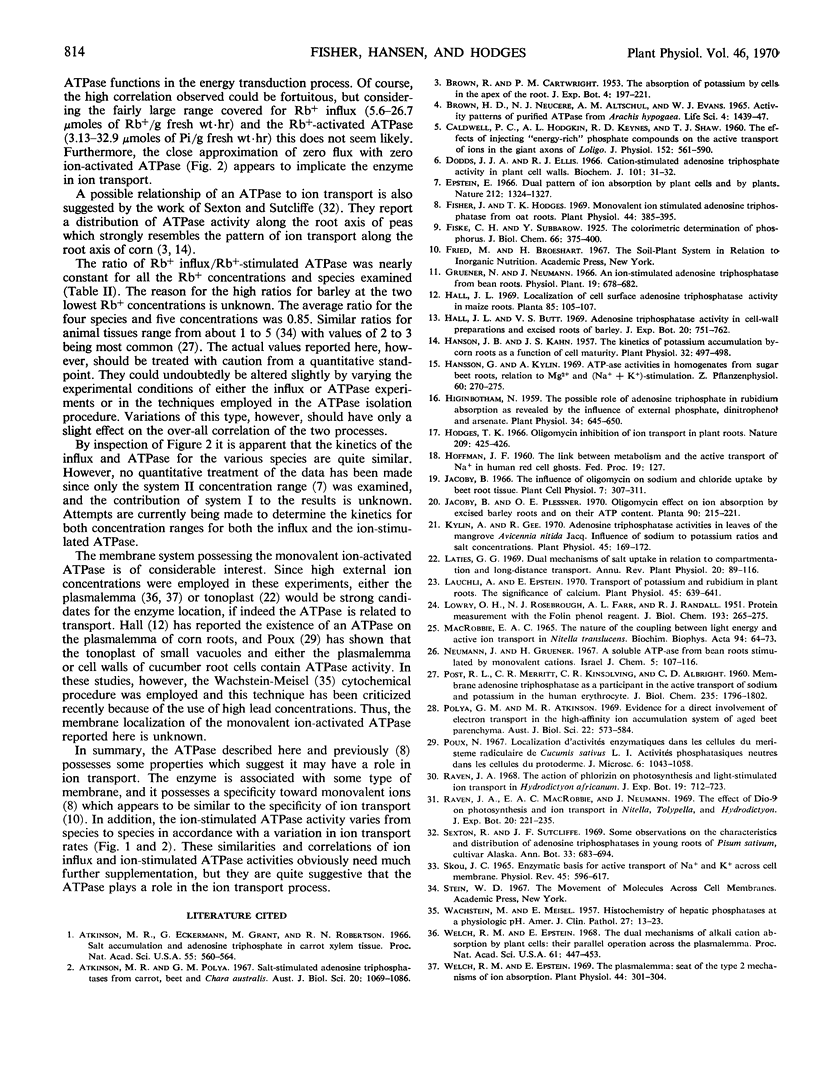Abstract
The energy-dependent influx of Rb+ into excised roots of corn, wheat, and barley has been determined and compared to the Rb+-stimulated ATPase activity of membrane fractions obtained from root homogenates of these species. The external Rb+ concentrations studied were in the range of 1 to 50 mm. The ratio of Rb+ influx/Rb+-stimulated ATPase was approximately 0.85 and was nearly constant for all the species and Rb+ concentrations studied. The correlation coefficient for Rb+ influx versus Rb+-activated ATPase was 0.94. The results support the concept that ATP is the energy source for ion transport in roots and that an ATPase participates in the energy transduction process involved in energy-dependent ion transport.
Full text
PDF


Selected References
These references are in PubMed. This may not be the complete list of references from this article.
- Atkinson M. R., Eckermann G., Grant M., Robertson R. N. Salt accumulation and adenosine triphosphate in carrot xylem tissue. Proc Natl Acad Sci U S A. 1966 Mar;55(3):560–564. doi: 10.1073/pnas.55.3.560. [DOI] [PMC free article] [PubMed] [Google Scholar]
- Brown H. D., Neucere N. J., Altschul A. M., Evans W. J. Activity patterns of purified ATPase from Arachis hypogaea. Life Sci. 1965 Jul;4(14):1439–1447. doi: 10.1016/0024-3205(65)90023-8. [DOI] [PubMed] [Google Scholar]
- CALDWELL P. C., HODGKIN A. L., KEYNES R. D., SHAW T. L. The effects of injecting 'energy-rich' phosphate compounds on the active transport of ions in the giant axons of Loligo. J Physiol. 1960 Jul;152:561–590. doi: 10.1113/jphysiol.1960.sp006509. [DOI] [PMC free article] [PubMed] [Google Scholar]
- Fisher J., Hodges T. K. Monovalent ion stimulated adenosine triphosphatase from oat roots. Plant Physiol. 1969 Mar;44(3):385–395. doi: 10.1104/pp.44.3.385. [DOI] [PMC free article] [PubMed] [Google Scholar]
- Hanson J. B., Kahn J. S. The Kinetics of Potassium Accumulation by Corn Roots as a Function of Cell Maturity. Plant Physiol. 1957 Sep;32(5):497–498. doi: 10.1104/pp.32.5.497. [DOI] [PMC free article] [PubMed] [Google Scholar]
- Higinbotham N. The Possible Role of Adenosine Triphosphate in Rubidium Absorption as Revealed by the Influence of External Phosphate, Dinitrophenol and Arsenate. Plant Physiol. 1959 Nov;34(6):645–650. doi: 10.1104/pp.34.6.645. [DOI] [PMC free article] [PubMed] [Google Scholar]
- Kylin A., Gee R. Adenosine Triphosphatase Activities in Leaves of the Mangrove Avicennia nitida Jacq: Influence of Sodium to Potassium Ratios and Salt Concentrations. Plant Physiol. 1970 Feb;45(2):169–172. doi: 10.1104/pp.45.2.169. [DOI] [PMC free article] [PubMed] [Google Scholar]
- LOWRY O. H., ROSEBROUGH N. J., FARR A. L., RANDALL R. J. Protein measurement with the Folin phenol reagent. J Biol Chem. 1951 Nov;193(1):265–275. [PubMed] [Google Scholar]
- Läuchli A., Epstein E. Transport of potassium and rubidium in plant roots: the significance of calcium. Plant Physiol. 1970 May;45(5):639–641. doi: 10.1104/pp.45.5.639. [DOI] [PMC free article] [PubMed] [Google Scholar]
- MACROBBIE E. A. THE NATURE OF THE COUPLING BETWEEN LIGHT ENERGY AND ACTIVE ION TRANSPORT IN NITELLA TRANSLUCENS. Biochim Biophys Acta. 1965 Jan 25;94:64–73. doi: 10.1016/0926-6585(65)90008-7. [DOI] [PubMed] [Google Scholar]
- POST R. L., MERRITT C. R., KINSOLVING C. R., ALBRIGHT C. D. Membrane adenosine triphosphatase as a participant in the active transport of sodium and potassium in the human erythrocyte. J Biol Chem. 1960 Jun;235:1796–1802. [PubMed] [Google Scholar]
- SKOU J. C. ENZYMATIC BASIS FOR ACTIVE TRANSPORT OF NA+ AND K+ ACROSS CELL MEMBRANE. Physiol Rev. 1965 Jul;45:596–617. doi: 10.1152/physrev.1965.45.3.596. [DOI] [PubMed] [Google Scholar]
- WACHSTEIN M., MEISEL E. Histochemistry of hepatic phosphatases of a physiologic pH; with special reference to the demonstration of bile canaliculi. Am J Clin Pathol. 1957 Jan;27(1):13–23. doi: 10.1093/ajcp/27.1.13. [DOI] [PubMed] [Google Scholar]
- Welch R. M., Epstein E. The dual mechanisms of alkali cation absorption by plant cells: their parallel operation across the plasmalemma. Proc Natl Acad Sci U S A. 1968 Oct;61(2):447–453. doi: 10.1073/pnas.61.2.447. [DOI] [PMC free article] [PubMed] [Google Scholar]
- Welch R. M., Epstein E. The plasmalemma: seat of the type 2 mechanisms of ion absorption. Plant Physiol. 1969 Feb;44(2):301–304. doi: 10.1104/pp.44.2.301. [DOI] [PMC free article] [PubMed] [Google Scholar]


